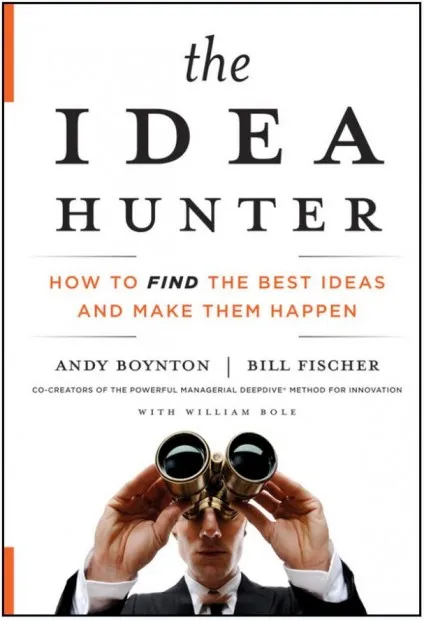[Book Review] The Idea Hunter: How to Find the Best Ideas and Make them Happen

2011 Jossey-Bass (Amazon)
6 chapters, 177 pages
Aspiring entrepreneurs, startups looking for new ways of expanding, and even employees in large organisations looking to explore creative avenues will find this book, The Idea Hunter, to be extremely insightful and practical.
This book joins a range of others by authors like Edward de Bono who advocate that creativity is a skill that can be mapped, understood, learned, applied and improved by any motivated employee or entrepreneur.
Other notable books in this field include Tom Kelley’s Art of Innovation and The Ten Faces of Innovation; Jeff Dyer, Hal Gregersen and Clayton Christensen’s The Innovator’s DNA; David Murray's Borrowing Brilliance; and Josh Linkner's Disciplined Dreaming.
Andy Boynton is Dean of the Carroll School of Management at Boston College. He was previously at the International Institute for Management Development (IMD) in Lausanne, and University of North Carolina at Chapel Hill. Bill Fischer is professor at IMD in Lausanne, and has lived much of his life in Asia and Europe. He was the President and Dean of the China Europe International Business School in Shanghai.
“Ideas matter,” the authors begin, showing how humanity has progressed not just through major blockbuster ideas but millions of tiny ideas as well (such as one-size-fits-all coffee cup lids!). The authors’ research shows that idea hunters are not generally geniuses, but ‘idea-active’ – they have a voracious appetite for acquiring new ideas and killed at setting those ideas in motion.
Before beginning the idea hunt, you should know what your ‘gig’ is – what you want to be, what you are good at, what you are noted for, what is unique about you, what space you want to be in, and what other people value in what you do. Based on this, the authors direct readers to map out their current ‘circle of competence’ – and try to keep pushing the boundaries into new and unexplored areas.
The authors describe in detail the four notable habits of i-d-e-a hunters: interest (i), diversification (d), exercise (e), agility (a) – an easy acronym to remember. I have summarised some activities and examples of these four principles in Table 1 below.
Table 1: Principles of Successful Idea Hunters
Based on these four principles, the authors come up with four “Ideaworks” for each set of objectives.
1. Keep quality time each day to yourself for new ideas (eg. Google and 3M allot 20 per cent of employee time for pet ideas and dabble time).
2. Bring together people with deep as well as broad skills (specialists and generalists). Avoid “ExpertThink” (the professional bubble, as referred to by Cindy Rabe, Intel strategist).
3. Assemble an idea portfolio of fresh and diverse ideas; identify sources of good ideas, progress in idea generation, practicability and novelty of new ideas. Keep ideas and inspiration accessible, eg. IDEO’s Tech Box collection of 400 gadgets.
4. Prioritise: do not pick too many ideas to follow at once, find the hot buttons, make it easy for customers to sample or try out your ideas, focus on idea benefits.
To sustain these principles, it is important to ‘create great conversations’ with people in multiple roles, and promote lateral thinking: connectors and gatekeepers. Responses in such conversations can be classified into continuers and terminators, or idea-busters and idea-builders.
“The great questions – the ones that propel innovation – will often come out of left field and surprise people. They might come from a person with a fresh perspective on the matter, perhaps a younger colleague or a new employee. Never underestimate the value of what might be called a naive expert,” the authors explain.
A good example is jazz clarinettist Buddy DeFranco, who identified new ideas by hanging around with ace jazz pianist Michael Dodo Marmarosa. Another example is a pen manufacturer who positioned its business not just as pens but gifts.
As important as learning is un-learning: altering mental pictures or frameworks in the face of new perspectives and opportunities.
“Few of us excel at all aspects of idea hunting,” the authors conclude. They also provide a questionnaire at the end of the book, which asks readers to rate themselves on factors such as their frequency of reading books, note-taking behaviours, meeting new people, amount of time devoted each day to thinking about new ideas, and social media sharing via blogs and tweets.
“Conversations are complex animals. In a sense all idea work is a conversation,” the authors sum up.
The book is filled with thought-provoking quotes, it would be apt to end this review with some of them:
“Good artists copy. Great artists steal.” – Pablo Picasso
“There is no one so stupid that he does not have something sensible to say.” – Roald Amundsen
“I have no special talents. I am only passionately curious.” – Albert Einstein
“Innovation begins with an eye.” – IDEO
“Creativity is an import-export business.” – Ronald Burt
“Some ideas look great from the bathtub, but turn out to be flimsy as soap bubbles.” – Olivia Judson
“You see, Watson, but you do not observe.” – Sherlock Holmes
“Personally, I don’t worry about originality at all.” – Twyla Tharp
“Chance favours the prepared mind.” - Louis Pasteur.
“To come up with ten good ideas, try to come up with hundred good ideas.” - David Kelley
“When I’m with composers, I say I’m a conductor. When I’m with conductors, I say I’m a composer.” - Leonard Bernstein
“Someone, somewhere has a better idea.” - Jack Welch
[Follow YourStory's research director Madanmohan Rao on Twitter at http://twitter.com/MadanRao ]


![[Book Review] The Idea Hunter: How to Find the Best Ideas and Make them Happen](https://images.yourstory.com/cs/wordpress/2012/12/IdeaHunterCover-424x620.jpg?mode=crop&crop=faces&ar=16%3A9&format=auto&w=1920&q=75)




